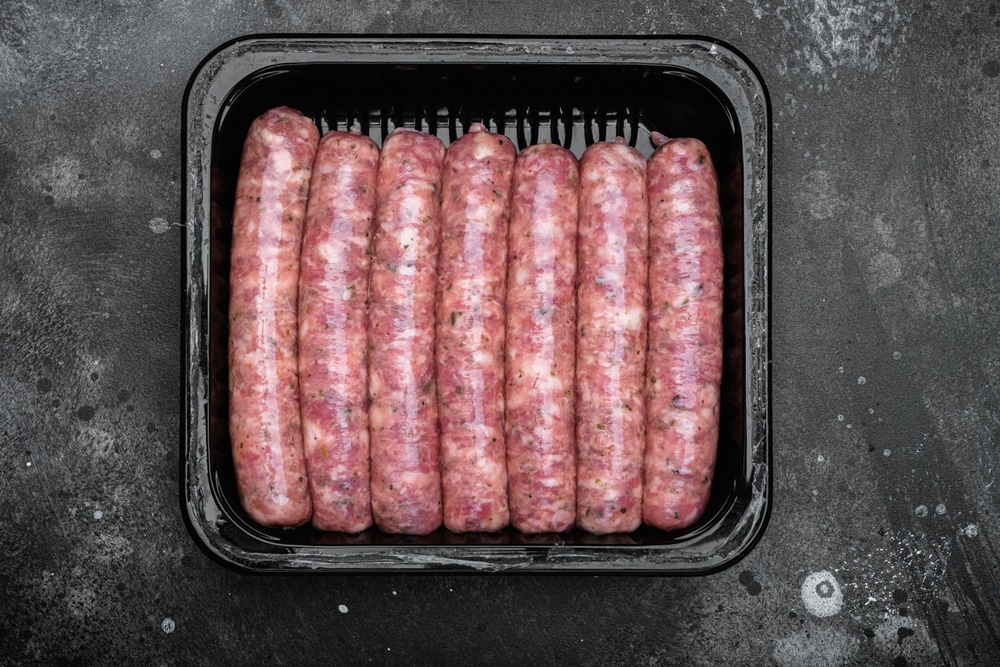
Sausages are one of the most delicious additions to the breakfast table, which is why many people stock them up in the freezer.
There are different types of sausages out there with different flavors but all of them need special storage techniques to make sure they retain the flavor and texture.
So, if you stored sausages in the freezer but they have turned brown, we are sharing the reason behind this browning, other signs of spoilage, and the right way of storing the sausages!
Sausage Turned Brown In Freezer
Browning In Sausages – What Does It Mean?
The sausages aren’t necessarily brown when they are frozen and is known as discoloration – the discoloration is caused by various reasons.
The speed and intensity of discoloration depend on the type of meat and the time you have stored them in the freezer for.
In most cases, the beef sausages turn brown or gray after a specific time but the poultry-based sausages don’t change in color.
The beef sausages turn brown or gray if you have stored them in the freezer for too long. It’s needless to say that freezing is a reliable preservation method but longer freezing can lead to changes in appearance.
Browning of sausages isn’t very common because the companies use preservatives. In particular, sodium nitrate is used to preserve the color of sausages and improves the overall appearance as well.
The brown and gray color of sausages is caused by oxidation – the sausages have a red color because of the presence of myoglobin, and when the sausages are exposed to air, they will become brown.
If the browning is happening due to oxidation, the sausages will be brown in the middle. However, oxidation doesn’t mean that the sausages have become spoiled.
Signs Of Spoiled Sausages
The sausages have a shelf life of only a few days, which is why freezing is recommended if you’ve to store the sausages for a longer time period.
Freezing sometimes causes grey and brown spots in the sausages but that doesn’t indicate spoilage. To help you out, we are sharing some actual signs of spoilage, such as;
- Appearance
First of all, you have to focus on the appearance of the sausages. Fresh and healthy sausages are pink or bright red in appearance, which is caused by the presence of oxymyoglobin in the meat.
In case the sausages are gray or brown from the inside, it means that the inner flesh hasn’t reacted with oxygen – this sausage will be healthy and safe to consume.
On the other hand, if the sausages have a dark grey or brown appearance on the surface, it means that the sausages have started to spoil and shouldn’t be consumed.
Secondly, if you identify a fuzzy blue or green appearance on the sausages, it means that there is mold growth in the sausages, and is not safe for consumption.
- Smell
The second common symptom of spoiled sausages is the pungent smell because the spoiled sausages stop smelling like fresh meat.
To illustrate, fresh sausages have a mild and meaty smell with a mild herb smell. On the contrary, spoiled sausages have a rancid, putrid, and pungent odor.
The pungent odor is caused by a higher volume of spoilage bacteria in the sausages. So, if the sausages have a tangy smell, it’s recommended that you discard the sausages.
- Texture
The third symptom of spoiled sausages is the textural changes. The fresh and healthy sausages have a firm consistency and it breaks apart whenever the meat is squeezed.
On the other hand, spoiled sausages will have a sticky and/or slimy texture because of bacterial buildup. For this reason, you should throw away such bacteria and wash your hands as well.
- Expiration Date
Last but not least, you have to keep an eye on the expiration date. The sausage packaging comes with an expiration date, so make sure you read the expiration date before frying and eating them.
Usually, refrigerated sausages have a shelf life of two days in the refrigerator. However, if you have frozen the sausages, always follow the expiration date.
In case there is no expiration date on the sausage packaging, you should check for the manufacturing date – the sausages should be consumed within four months of the manufacturing date.
The Shelf Life Of Sausages
The fresh sausages in raw form stay fresh for a few days to months, depending on the storage method. Ideally, you should consume the sausages before the expiration date.
The expiration date indicates the last date that the sausage will be fresh and high-quality. When stored in the refrigerator, the sausages will remain fresh for two days as long as the temperature reaches 40 degrees Fahrenheit.
Secondly, you should try to consume sausages within two to three months of purchasing, particularly if you have frozen the sausages – the sausages must be wrapped up properly to prevent freezer burns.
On the other hand, the cooked and pre-cooked sausages can be kept in the refrigerator for three to four days and for two to four months in the freezer.
The Correct Way To Freeze The Sausages
Proper freezing of the sausages is essential to make sure it doesn’t get spoiled or become brown or grey. In addition, it will ensure that sausages remain fresh for over four months. The freezing instructions include;
- First of all, you have to separate your sausages into meal-sized portions. It will make it easier to take them out of the freezer and fry them. It’s recommended that you set four ounces to eight ounces portions for one person.
- The second step is to wrap the sausages in a plastic cling wrap or use a high-end vacuum-sealed bag to make sure the sausages aren’t exposed to air (air exposure causes discoloration).
- Then, you have to wrap the sausages in aluminum foil or you can use the second layer of cling wrap or a bag to ensure proper storage.
- The next step is to write down the expiration date on the packaging and put it in the coldest part of the freezer.
So, are you ready to enjoy the sausages?.




